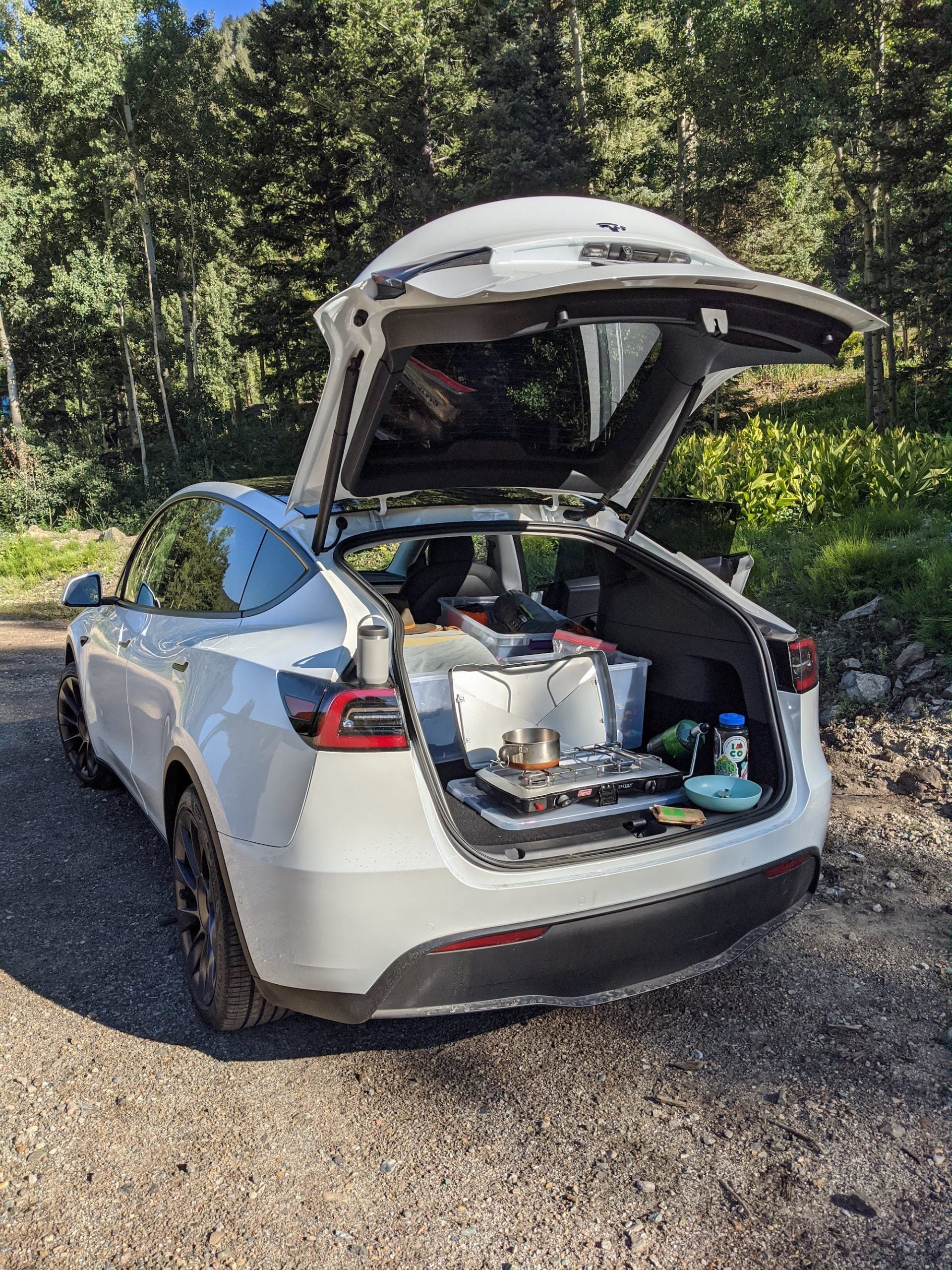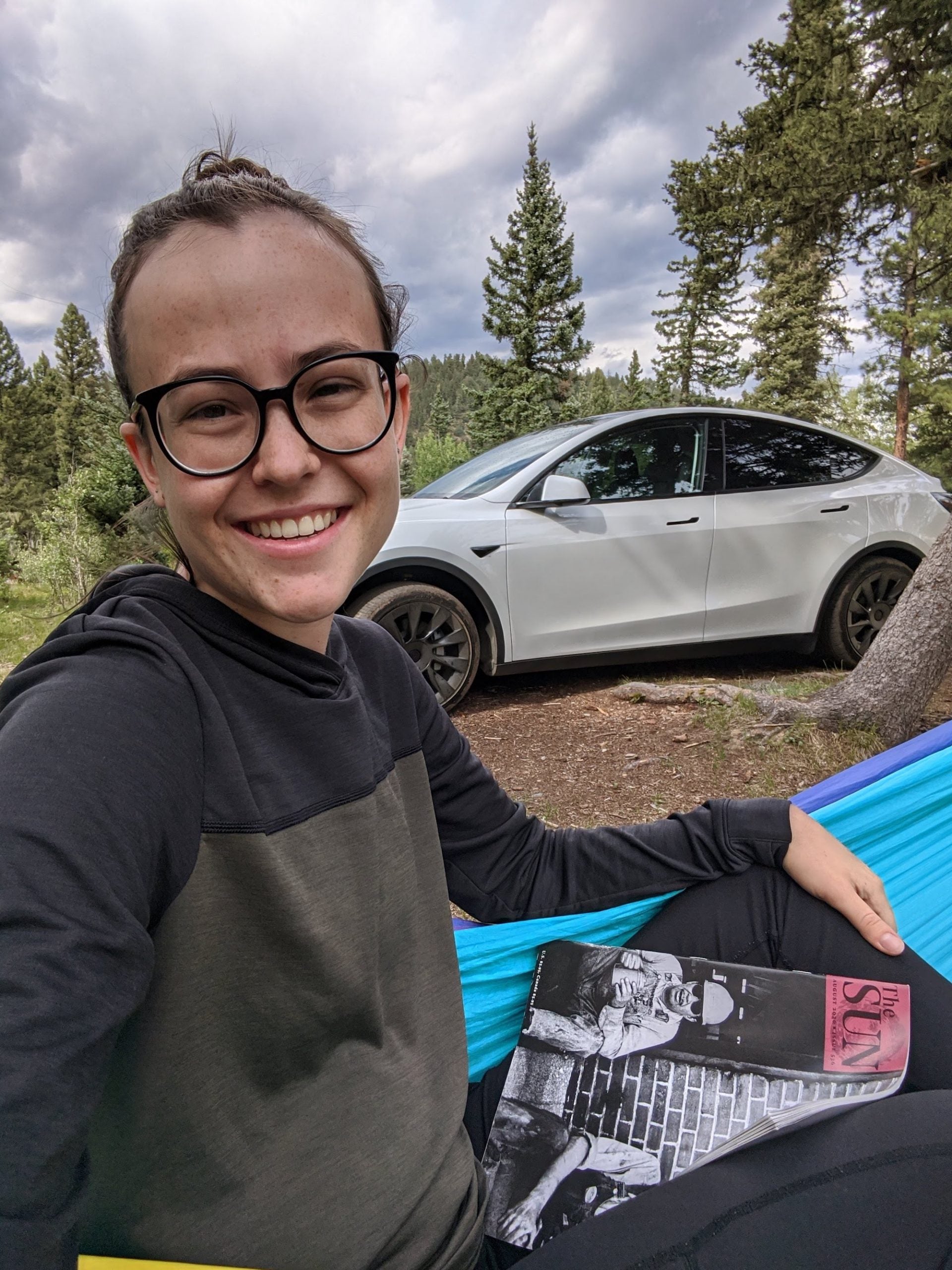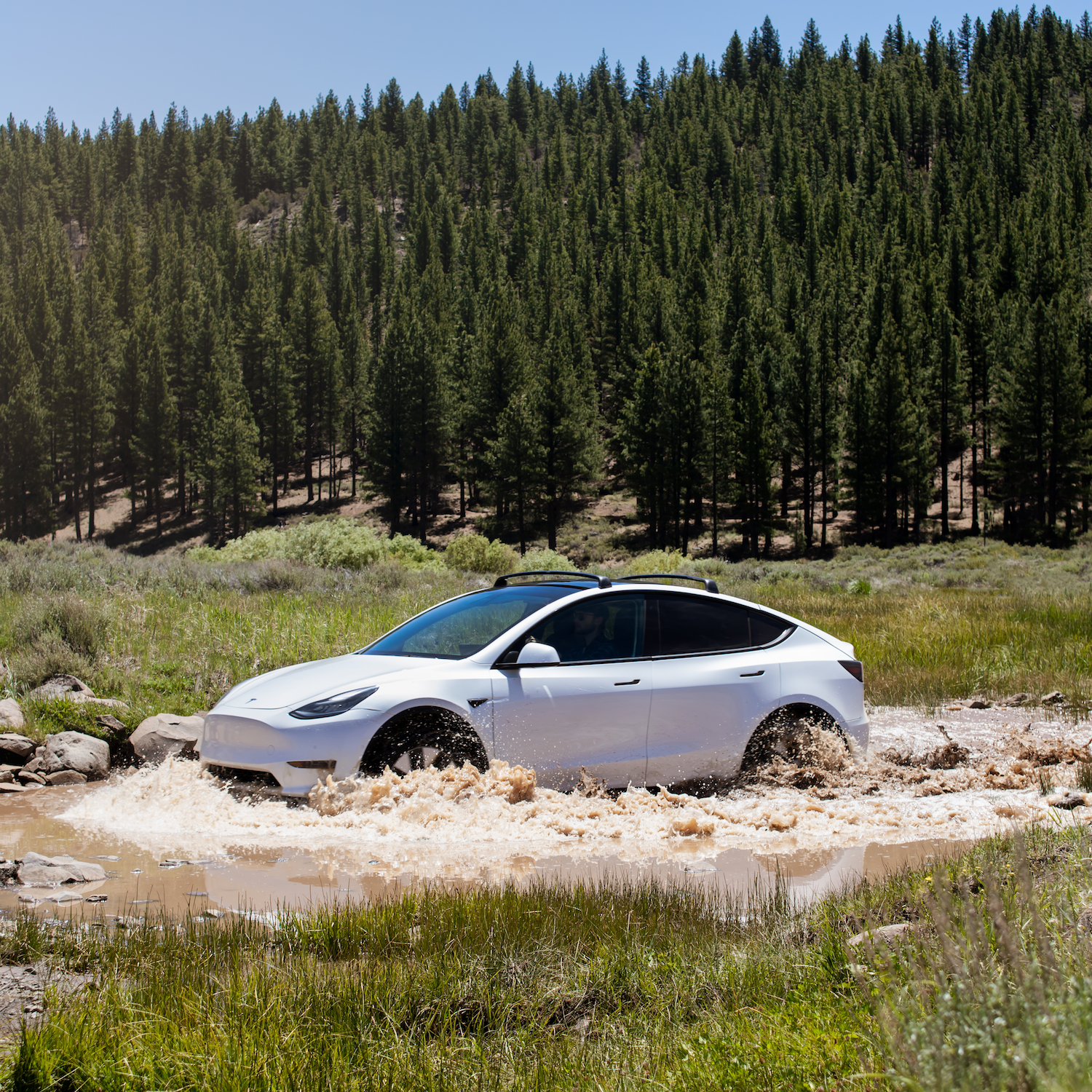I was sitting in a ski-area parking lot, watching an early-2000s rom-com on the 15-inch screen of a Tesla and eating trail mix, when I realized that, if only there were a couple feet of snow on the ground, I would be living my wildest ski-bum dreams.╠ř
I usually drive Whatshername, a 2011 Ford Fusion named after a . I inherited the low-clearance, front-wheel-drive sedan from my grandpa when I graduated from college. ItÔÇÖs no adventuremobile, but it gets good mileage, and its all-season tires make it not completely unsafe in most on-road conditions. If I fold down the rear seats, I can just barely fit my five-foot-five╠řframe in the back to catch some zÔÇÖs. Kelly Blue Book says parting with it would net me about $5,000. But this weekend, Whatshername was gathering dust, and I was behind the wheel of a car with a valuation more than ten times as high: a . When it showed up at my apartment in a giant trailer, three of my neighbors yelled some variant of ÔÇťNice car!ÔÇŁ That certainly never happened with my Fusion.

The Model Y is TeslaÔÇÖs fifth and latest iteration, which hit the road in March 2020 with a base price of $51,990. The version I tested, with the full self-driving package, sells for╠ř$59,990. (The rep who hooked me up with a testing vehicle pointed out that the existing models together spell S3XY, which is apparently how Elon╠řMusk╠řwants us to think of his creations.) The Y is a midsize all-wheel-drive SUV with an exceptionally roomy interior. (Tesla has plans to launch a rear-wheel-drive version╠řin the near future.)╠řIn size and general layout, itÔÇÖs comparable to a Subaru Outback but╠řfully electric, and the inside looks like a spaceship. Compared to the slightly cheaper Model 3, on which the Y is based, the Y is a bit more versatile, thanks to that added space.╠řAnd its 350-mile range makes it, in theory, still well suited for longer tripsÔÇöa tough frontier, historically, for electric vehicles to breach, despite an increase in╠řcharging networks.
One of TeslaÔÇÖs biggest selling points is its network of ÔÇönearly 1,000 fast-charging 250-kilowatt stations in North America╠řplaced along well-traveled routes, which can fully recharge a Model Y in about an hour for roughly $20. (New Mexico, where I live, has ten of these stations.) The Supercharger network is supplemented by slower-charging destination chargers, which are typically found at places like hotels, restaurants, and office parks, where youÔÇÖd expect to stay put╠řfor more than an hour╠řat a time. They vary in voltage and are generally╠řfree for use as╠řthe businessÔÇÖs patrons. Finally, there are third-party electric-vehicle chargers, which tend to require payment through an app or a credit card. Most Tesla owners, however, will slow-charge at home while the car is not in use.
I put the Y to the test on a weekend trip through northern New Mexico in late July. During the two-hour drive from Santa Fe to Taos, I made full use of the carÔÇÖs luxe features. Usually╠řmy phone is jammed in a cup holder and tethered to Whatsername via a dense web of tangled auxiliary cables, chargers, and dongles, but in the Model Y, I simply placed it on a charging pad under the display and seamlessly connected it with Bluetooth. As ÔÇťÔÇŁ streamed out of the crystal-clear, bass-heavy speakers, I put on my sunglasses and was filled with that open-road sense of endless possibility. I felt like I was in the middle of a sunny road-trip montage in a Hollywood blockbuster.
On the highway, I dabbled in TeslaÔÇÖs self-driving modeÔÇöan $8,000 optional driver-assistance system which ÔÇťseesÔÇŁ the road via eight external cameras, forward-facing radar, and 12 ultrasonic sensors to allow for traffic-aware cruise control, in-lane steering, parking assistance, automatic lane changes, and other features. (All Teslas come with basic adaptive cruise control.) This isnÔÇÖt a fully autonomous system: the driver must remain engaged, with hands on the steering wheel and eyes on the road. It was unsettling at first to have the car steer itself under my hands, but also╠řsurprising how quickly it began to feel normal. I tested the carÔÇÖs smooth, electric acceleration, which felt like a high-speed train departing a station or a roller coaster taking off, with none of my sedanÔÇÖs pained revving as it tries to get up to highway speeds.╠ř
I put on my sunglasses and was filled with that open-road sense of endless possibility. I felt like I was in the middle of a sunny road-trip montage in a Hollywood blockbuster.
I arrived 70 miles later in Taos with a little more than half the battery leftÔÇönot quite enough for a round-trip╠řto the dispersed camping on Forest Service land I was aiming forÔÇöand discovered that the small townÔÇÖs two slow destination chargers were powered off or inaccessible. So I╠řheaded 30 minutes north to the ski area to pick up some juice at a third-party slow-charging outlet in hopes of salvaging the next day of my trip.╠ř
Not only have I never driven an electric vehicle before, where the time it takes to charge it is as much of a consideration╠řas the distance to a hookup spot, but╠řmy Fusion can make it about 500 miles on a tank, so I rarely worry about fuel or distance. I drove to Taos countless times last winter, and while I may have been anxious about my tires spinning on the ice, I wasnÔÇÖt ever concerned about my dashboard fuel indicator pointing at E.
At the Taos resort, I plugged in. ÔÇťThree hours╠ř40 minutes,ÔÇŁ╠řthe display read, letting me know how much time I had to kill until the battery recharged. This was definitely a change from a ten-minute gas-station pit stop. I used the time to explore the grassy ski slopes, but as the sun set and it started to rain, I had to do some electric-vehicle calculus. I could leave with the car partially charged, try to find a level spot along the road in the semidarkness, and limit my range for the next dayÔÇÖs activities, or I could call it a night, sleep in the parking lot with its resident╠řtrailer-camping mountain bikers, and hang out with JLo and Matthew McConaughey for a while. It was not a difficult choice.╠ř
One drive-in-esque cheesy movie experience and a full charge later, I was snuggled up in my sleeping bag in the back of the car, trying to make out the faint pinpricks of stars through the tinted glass roof. The rear seats laid flatter than the ones in my car, and I didnÔÇÖt have to jam my feet into a claustrophobia-inducing closed trunk. And there was a view,╠řbesides. Still, anyone much taller than me wouldnÔÇÖt be able to sleep in the carÔÇöat just 68 inches long, I was maxing out the trunk space with three inches to spare.╠ř
As I drifted off, I thought idly about how terrifying it would be to wait out a hailstorm in a $52,000 car with a full glass roof.
Several bouts of mysterious whirring and clunking sounds and╠řa few inexplicable display wake-ups led me to do╠řsome systematic Bluetooth key and door-lock testing.╠řI determined that if I wanted the car to stay locked and powered off while I slept inside, I would need to disconnect╠řmy phone after buttoning up for the night╠řto prevent its proximity to the car from turning on the climate control or automatically unlocking the doors if someone pulled on a handle. As I drifted off, I thought idly about how terrifying it would be to wait out a hailstorm in a $52,000 car with a full glass roof.
The next morning, I awoke early to sunlight streaming in through the near 360-degree glass bubble around me. The skies had cleared, and the view of the resort, even from the parking lot, was beautiful. Feeling well rested, I stretched, unzipped my sleeping bag, and pressed the door-open button. The carÔÇÖs alarm pierced the morning calm, and I scrambled to reconnect to Bluetooth before I incurred the wrath of my fellow vehicular campers. IÔÇÖm not even sure my own car still has a functioning alarm.╠ř
When my heart rate returned to normal, I fired up my stove on the low, flat tailgate to make coffee and oatmeal. I pulled half-and-half from my cooler, stowed in the perfectly sized 24-by-15-by-15-inch╠řstorage well beneath the trunkÔÇÖs floor, where my Ford holds a spare tire, which is probably more practical╠řbutÔÇöletÔÇÖs face itÔÇömuch less cool. Instead of including spares in its vehicles, Tesla provides a free roadside-assistance hotline, which works as long as you donÔÇÖt break down out of cell-service range. The hatch, which opens to a clearance of 76 inches, allowed me to move freely beneath╠řit, and the enormous amount of storage space meant I didnÔÇÖt have to dig around for anything while I went about my morning routine.
With both the TeslaÔÇÖs and my batteries recharged, I resumed my plan, driving back to town and then east to find a campsite and some hiking for the day. My route took me off the highway and onto a classic New Mexico back road: rocky, rutted, and poorly maintained. With 6.6 inches of ground╠řclearance and all-wheel drive, the Tesla╠řwas a slight improvement on the Fusion, which only features╠ř5.3 inches of clearance and front-wheel drive. I nervously navigated╠řdown a heavily rutted side road to a secluded site with a level parking spot and trees spaced just right for a hammock.╠ř

Before I could settle in, it began to drizzle. I postponed my hiking and hammock plans╠řand hunkered down in the car as rain turned to hail. Being in any car during a hailstorm is an unpleasantly loud experience, but IÔÇÖm never too worried about Whatsername getting a few dings. I figure they show character. In the Tesla, however, it was a nightmare. What if the rutted dirt road washed out completely and I couldnÔÇÖt get back to the highway? What if the glass shattered? (A search of Tesla owner forums after the fact indicated that the latter was , and Tesla says its╠řinternal tests have shown the glass to be more impact-resistant than aluminum.)╠ř
The storm lasted through the afternoon and into the evening, but luckily the hail didnÔÇÖt grow large enough to be a real threat. Finally far enough from civilization to have lost a cell signal, I put my phone on airplane mode. The car was silent, detached from its Bluetooth lifeline. With another movie night out of the question, and the TeslaÔÇÖs techy features rendered inert, the forest around me came into focus. For the first time in days, I didnÔÇÖt worry about where IÔÇÖd charge next or how IÔÇÖd get there. I crawled into my sleeping bag and watched the rain through the roof, soaking up the disconnected bliss of being out there and alone.╠ř


